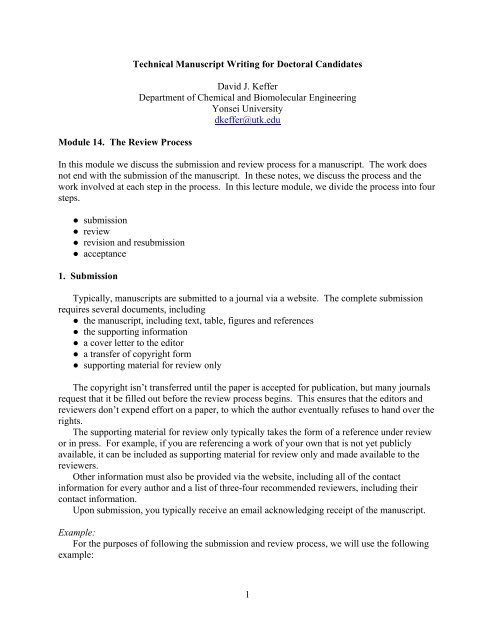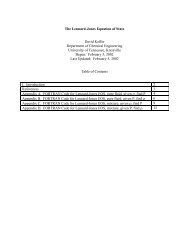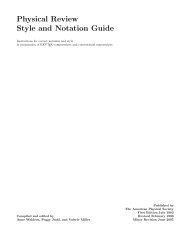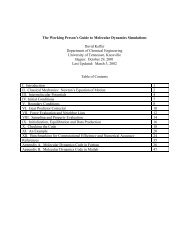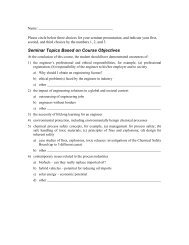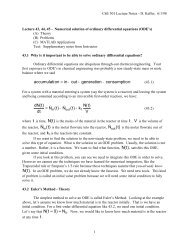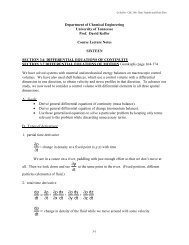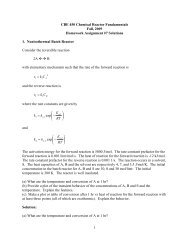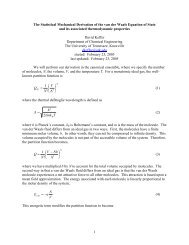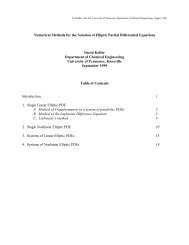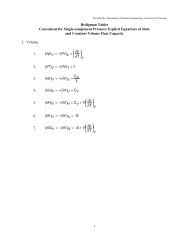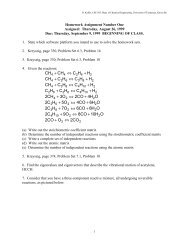The Submission and Review Process
The Submission and Review Process
The Submission and Review Process
Create successful ePaper yourself
Turn your PDF publications into a flip-book with our unique Google optimized e-Paper software.
Module 14. <strong>The</strong> <strong>Review</strong> <strong>Process</strong>Technical Manuscript Writing for Doctoral C<strong>and</strong>idatesDavid J. KefferDepartment of Chemical <strong>and</strong> Biomolecular EngineeringYonsei Universitydkeffer@utk.eduIn this module we discuss the submission <strong>and</strong> review process for a manuscript. <strong>The</strong> work doesnot end with the submission of the manuscript. In these notes, we discuss the process <strong>and</strong> thework involved at each step in the process. In this lecture module, we divide the process into foursteps.● submission● review● revision <strong>and</strong> resubmission● acceptance1. <strong>Submission</strong>Typically, manuscripts are submitted to a journal via a website. <strong>The</strong> complete submissionrequires several documents, including● the manuscript, including text, table, figures <strong>and</strong> references● the supporting information● a cover letter to the editor● a transfer of copyright form● supporting material for review only<strong>The</strong> copyright isn’t transferred until the paper is accepted for publication, but many journalsrequest that it be filled out before the review process begins. This ensures that the editors <strong>and</strong>reviewers don’t expend effort on a paper, to which the author eventually refuses to h<strong>and</strong> over therights.<strong>The</strong> supporting material for review only typically takes the form of a reference under reviewor in press. For example, if you are referencing a work of your own that is not yet publiclyavailable, it can be included as supporting material for review only <strong>and</strong> made available to thereviewers.Other information must also be provided via the website, including all of the contactinformation for every author <strong>and</strong> a list of three-four recommended reviewers, including theircontact information.Upon submission, you typically receive an email acknowledging receipt of the manuscript.Example:For the purposes of following the submission <strong>and</strong> review process, we will use the followingexample:1
Wang, Q., Keffer, D.J., Nicholson, D.M., Thomas, J.B., “Coarse-grained MolecularDynamics Simulation of Polyethylene Terephthalate (PET)”, Macromolecules, in press,DOI: 10.1021/ma102084a, 2010.<strong>The</strong> document included in the submission of this manuscript are provided on the course website<strong>and</strong> include● the manuscript, including text, table, figures <strong>and</strong> references● the supporting information● a cover letter to the editor2. <strong>Review</strong>In general, the manuscript is sent an editor. <strong>The</strong> editor then makes a decision whether thepaper has any chance to appear in the journal. If the editor decides that the paper is notsufficiently appropriate to merit external review, then s/he will return the manuscript withoutreview. <strong>The</strong> higher impact the journal is, the more likely an editor is to return a manuscriptwithout external review. <strong>The</strong>re is little point in arguing with an editor that has chosen not tohave the manuscript reviewed. Typically there may be a few sentences providing the reason thatthe paper did not merit external review. <strong>The</strong> appropriate course of action is to (1) read thereason, (2) adjust the manuscript accordingly, if applicable <strong>and</strong> (3) reformat the paper forsubmission to a different journal.If the editor send the manuscript out for review, you wait about a month before you receivethe reviewer’s comments. Usually, the editor tries to send all the reviews at the same time.Sometimes, a late review arrives <strong>and</strong> the editor sends it afterward.Example:For our example [Wang et al., Macromolecules, 2010], the three reviews of this manuscriptare provided on the course website. Typically the reviewers are asked to make a generalrecommendation in addition to providing specific comments. <strong>The</strong> general recommendationsusually are● publish as is (no changes needed)● minor revision (does not need to be reviewed again)● major revision (needs to be reviewed again)● rejectIn this case, the first reviewers suggests “major revision”. <strong>The</strong> second two reviewers suggest“minor revision”.Please note that these reviews contain valuable information for improving the manuscript.Each suggestion should be carefully considered.2
3. Revision <strong>and</strong> ResubmissionAssuming that the reviews call for modifications, which is the typical case, one must submita revised manuscript. <strong>The</strong> materials submitted for the revised manuscript include● the revised manuscript, including text, table, figures <strong>and</strong> references● the revised supporting information● a cover letter to the editor● an itemized response to the reviewers’ commentsThis last document, an itemized response to the reviewers’ comments, must be examined ingreater detail.Example:For our example [Wang et al., Macromolecules, 2010], two documents related toresubmission are included on the course website:● the revised manuscript● a cover letter to the editor, including an itemized response to the reviewers’ commentsIt is instructive to study the itemized response to the reviewer’s comments.<strong>The</strong> reviewer makes his/her comments because they want to see changes in the publishedmanuscript. <strong>The</strong> purpose of the itemized response to the reviewer is not to argue with thereviewer. This will not help in the slightest. Presenting long arguments in the response to thereviewer without corresponding changes in the revised manuscript is not useful. One shouldclearly indicate whether or not changes were made in response to each of the reviewer’scomments.One should consider all of the reviewers’ comments. Where the reviewer simplymisunderstood the paper (or in your opinion read it carelessly), one should take this as anopportunity to clarify that particular aspect of the paper so that even a careless reader comesaway with the correct message.If the reviewer recommends that one include additional citations to relevant work, then oneshould include those references. This can often be done with a single sentence <strong>and</strong> will assuagethe reviewer. Only in egregious cases, should a request for the inclusion of a citation be ignored.If the reviewer recommends that new work be performed, then one must consider this. If thenew work is additional analysis of existing data, then one should make every effort to do thisextra work. It can be included in the supplementary information if you judge it not to be centralto the work.If the reviewer asks that a large amount of work be done, or that analysis be done that wouldrequire repeating old work, then the authors may decline to adopt this suggestion. However,there must be a justification for declining each suggestion. Frequently, rather than just flat out3
stating that you will not agree to the request, you may find some less arduous alternative thatmay placate the reviewer.Remember: Always be civil in a review <strong>and</strong> in the response to the reviewer. We are allhuman beings. We don’t like to hear bad news. Keep in mind that a negative review can beviewed as “free constructive criticism”.If you receive a thoroughly nasty review, remember also that some people are just bornassholes. Take a deep breath <strong>and</strong> move on. Do not sink to the level of an uncivil reviewer.Editors appreciate civility <strong>and</strong> will over-rule an obviously biased or hostile reviewer.4. AcceptanceEven when the manuscript is accepted for publication, the work is not done. Typicallywithin a week or two of acceptance, the manuscript will be reformatted by the journal staff. A“galley proof” will be sent to the authors. This galley proof shows how the paper will appear inthe journal.It is the duty of the graduate student to make sure that no errors were added to the paper bythe journal staff in the reformatting process. Sometimes the journal staff have questions <strong>and</strong>these queries must be answered. Sometimes, errors are made. Typical places for errors are inthe equations <strong>and</strong> the references. <strong>The</strong>se have to be checked thoroughly.Note, journals do not allow changes in the manuscript at the galley stage beyond errorcorrection. <strong>The</strong> manuscript should be published as it was approved by review. Changes to themanuscript after review are not allowed because they circumvent the review process. <strong>The</strong>y alsocreate extra work for the journal staff.Example:For our example [Wang et al., Macromolecules, 2010], one documents related to acceptanceis included on the course website:● the galley proofIn this example, we did not find any errors in the galley proof. We approved it as is.4


